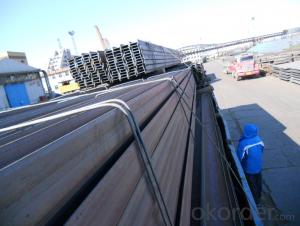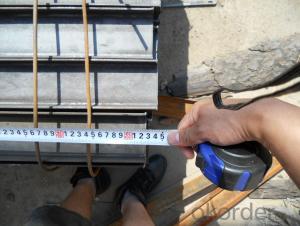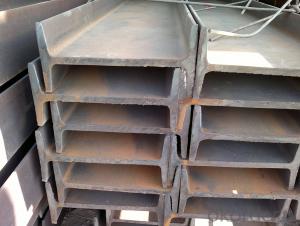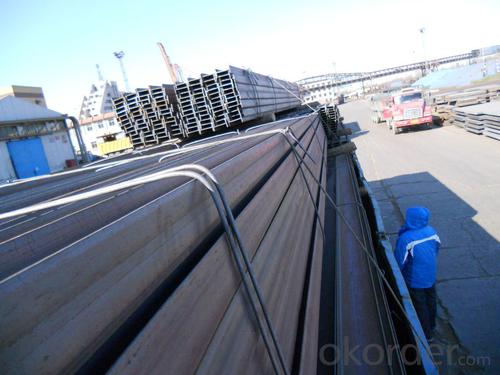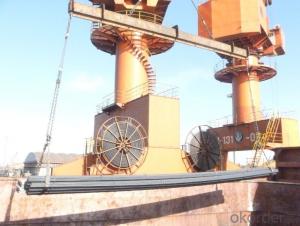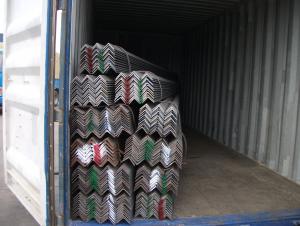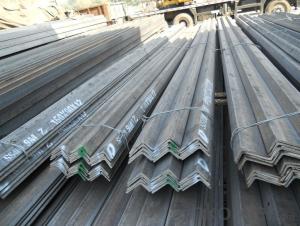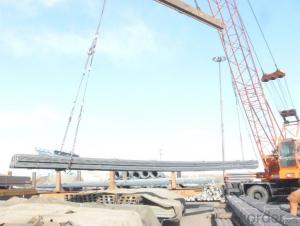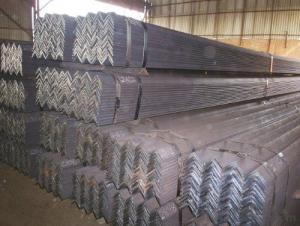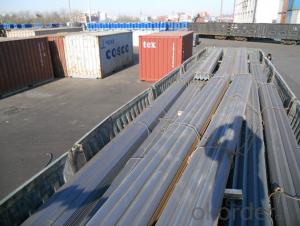High Quality Hot Rolled Steel Equal Angle Equal Angle for Construction
- Loading Port:
- Tianjin
- Payment Terms:
- TT OR LC
- Min Order Qty:
- 25 m.t.
- Supply Capability:
- 2000000 m.t./month
OKorder Service Pledge
OKorder Financial Service
You Might Also Like
Specification
Product Description:
OKorder is offering High Quality Hot Rolled Steel Equal Angle Equal Angle for Construction at great prices with worldwide shipping. Our supplier is a world-class manufacturer of steel, with our products utilized the world over. OKorder annually supplies products to European, North American and Asian markets. We provide quotations within 24 hours of receiving an inquiry and guarantee competitive prices.
Product Applications:
High Quality Hot Rolled Steel Equal Angle Equal Angle for Construction are ideal for structural applications and are widely used in the construction of buildings and bridges, and the manufacturing, petrochemical, and transportation industries.
Product Advantages:
OKorder's High Quality Hot Rolled Steel Equal Angle Equal Angle for Construction are durable, strong, and resist corrosion. They are newly produeced by good materiales.
Main Product Features:
· Premium quality
· Prompt delivery & seaworthy packing (30 days after receiving deposit)
· Corrosion resistance
· Can be recycled and reused
· Mill test certification
· Professional Service
· Competitive pricing
Product Specifications:
Specifications of High Quality Hot Rolled Steel Equal Angle Equal Angle for Construction
1. Invoicing on theoretical weight or actual weight as customer request
2. Length: 6m, 9m, 12m as following table
3. Sizes
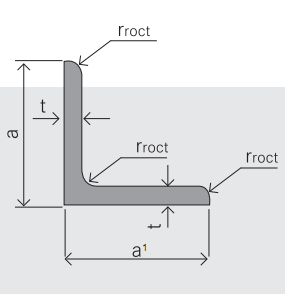
Sizes: 25mm-250mm | ||
a*t | ||
25*2.5-4.0 | 70*6.0-9.0 | 130*9.0-15 |
30*2.5-6.6 | 75*6.0-9.0 | 140*10-14 |
36*3.0-5.0 | 80*5.0-10 | 150*10-20 |
38*2.3-6.0 | 90*7.0-10 | 160*10-16 |
40*3.0-5.0 | 100*6.0-12 | 175*12-15 |
45*4.0-6.0 | 110*8.0-10 | 180*12-18 |
50*4.0-6.0 | 120*6.0-15 | 200*14-25 |
60*4.0-8.0 | 125*8.0-14 | 250*25 |
5. Payment terms:
1).100% irrevocable L/C at sight.
2).30% T/T prepaid and the balance against the copy of B/L.
3).30% T/T prepaid and the balance against L/C
6.Material details:
Alloy No | Grade | Element (%) | |||||
C | Mn | S | P | Si | |||
Q235 | B | 0.12—0.20 | 0.3—0.7 | ≤0.045 | ≤0.045 | ≤0.3 | |
Alloy No | Grade | Yielding strength point( Mpa) | |||||
Thickness (mm) | |||||||
≤16 | >16--40 | >40--60 | >60--100 | ||||
≥ | |||||||
Q235 | B | 235 | 225 | 215 | 205 | ||
Alloy No | Grade | Tensile strength (Mpa) | Elongation after fracture (%) | ||||
Thickness (mm) | |||||||
≤16 | >16--40 | >40--60 | >60--100 | ||||
≥ | |||||||
Q235 | B | 375--500 | 26 | 25 | 24 | 23 | |
Usage & Applications of High Quality Hot Rolled Steel Equal Angle Equal Angle for Construction
According to the needs of different structures, Angle can compose to different force support component, and also can be the connections between components. It is widely used in various building structures and engineering structures such as roof beams, bridges, transmission towers, hoisting machinery and transport machinery, ships, industrial furnaces, reaction tower, container frame and warehouse etc.
Packaging & Delivery of High Quality Hot Rolled Steel Equal Angle Equal Angle for Construction
1. Packing: it is nude packed in bundles by steel wire rod
2. Bundle weight: not more than 3.5MT for bulk vessel; less than 3 MT for container load
3. Marks:
Color marking: There will be color marking on both end of the bundle for the cargo delivered by bulk vessel. That makes it easily to distinguish at the destination port.
Tag mark: there will be tag mark tied up on the bundles. The information usually including supplier logo and name, product name, made in China, shipping marks and other information request by the customer.
If loading by container the marking is not needed, but we will prepare it as customer request.
Production flow of High Quality Hot Rolled Steel Equal Angle Equal Angle for Construction
Material prepare (billet) —heat up—rough rolling—precision rolling—cooling—packing—storage and transportation
FAQ:
Q1: Why buy Materials & Equipment from OKorder.com?
A1: All products offered byOKorder.com are carefully selected from China's most reliable manufacturing enterprises. Through its ISO certifications, OKorder.com adheres to the highest standards and a commitment to supply chain safety and customer satisfaction.
Q2: How do we guarantee the quality of our products?
A2: We have established an advanced quality management system which conducts strict quality tests at every step, from raw materials to the final product. At the same time, we provide extensive follow-up service assurances as required.
Q3: How soon can we receive the product after purchase?
A3: Within three days of placing an order, we will begin production. The specific shipping date is dependent upon international and government factors, but is typically 7 to 10 workdays.
Images:
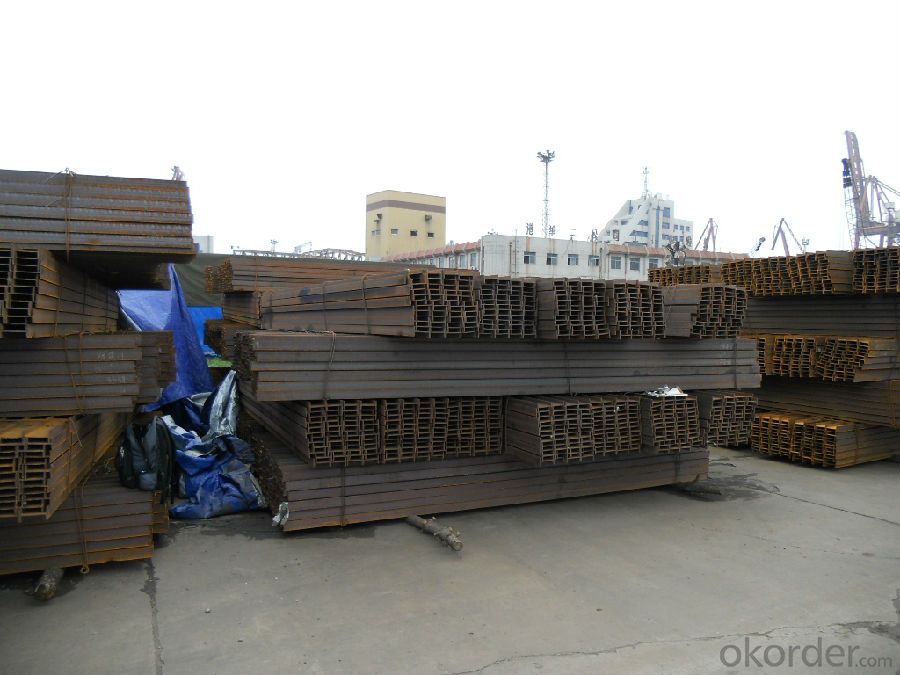
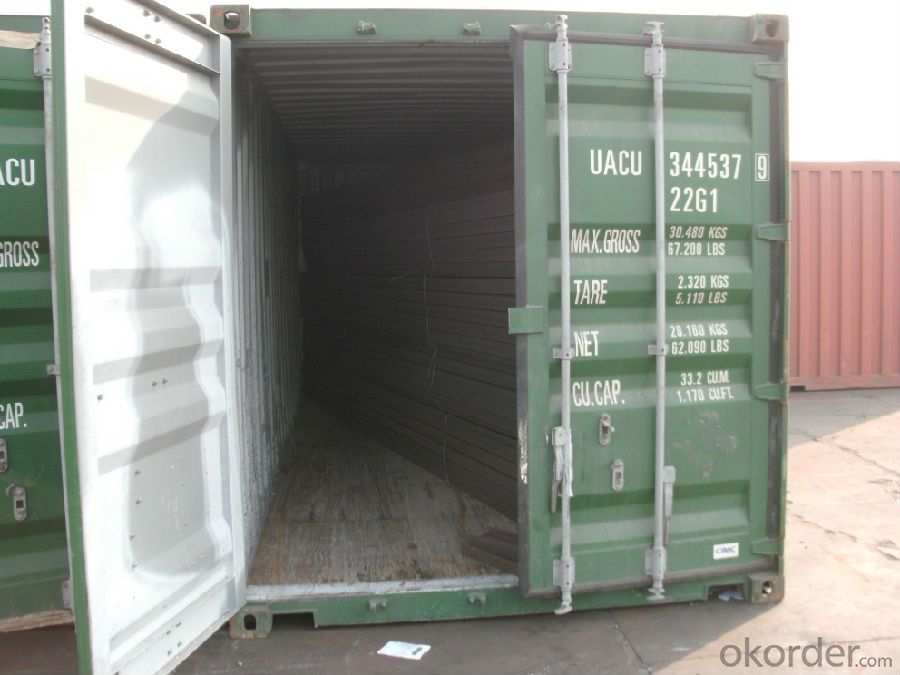
- Q: What are the different types of connections used for steel angles in industrial settings?
- There are various types of connections used for steel angles in industrial settings, including bolted connections, welded connections, and riveted connections. These connections provide structural support and stability to steel angles, ensuring their integrity and strength in industrial applications.
- Q: Can steel angles be used in the construction of pedestrian bridges?
- Indeed, the utilization of steel angles is feasible in the construction of pedestrian bridges. Owing to their robustness and longevity, steel angles are widely employed in construction. They serve the purpose of offering structural support and stability to pedestrian bridges, while also enabling the creation of frames, beams, and trusses. The adaptability in design and construction is facilitated by the ease of welding or bolting steel angles together. Moreover, steel angles can be galvanized or coated, amplifying their resistance to corrosion and rendering them suitable for outdoor applications like pedestrian bridges. All in all, steel angles emerge as a versatile and dependable option for the construction of pedestrian bridges.
- Q: What are the different surface treatments available for steel angles?
- There are several different surface treatments available for steel angles, each offering unique benefits and applications. Some of the most common surface treatments for steel angles include galvanization, painting, powder coating, and hot-dip coating. Galvanization is a process that involves coating the steel angles with a layer of zinc. This treatment provides excellent corrosion resistance, making the steel angles suitable for outdoor and marine applications. The zinc layer acts as a sacrificial barrier, protecting the underlying steel from rust and other forms of corrosion. Painting is another popular surface treatment for steel angles. It involves applying a coat of paint to the surface of the angles, adding both aesthetic appeal and protection. The paint can be customized to match specific color requirements and can provide additional resistance against environmental factors such as moisture and UV radiation. Powder coating is a technique that involves applying a dry powder to the steel angles and then heating it to create a durable and attractive coating. This treatment offers excellent resistance to scratches, chemicals, and fading, making it a popular choice for industrial and architectural applications. Powder coating also provides a wide range of color options and a smooth, even finish. Hot-dip coating is a process where the steel angles are immersed in a bath of molten zinc. This treatment creates a thick, bonded coating that offers exceptional corrosion resistance. Hot-dip coating is commonly used in applications where the steel angles will be exposed to harsh environments, such as construction, infrastructure, and automotive industries. In summary, the different surface treatments available for steel angles include galvanization, painting, powder coating, and hot-dip coating. Each treatment provides unique benefits and protection, allowing the steel angles to be used in various industries and applications.
- Q: What are the common surface treatments for steel angles to enhance corrosion resistance?
- The common surface treatments for steel angles to enhance corrosion resistance include galvanizing, painting, and powder coating.
- Q: How do you calculate the second moment of area for a steel angle?
- In order to determine the second moment of area for a steel angle, a step-by-step procedure must be followed. The following guidelines outline how this can be accomplished: 1. Initiate the process by sketching the cross-section of the steel angle on either paper or a CAD software platform. Ensure that all dimensions are accurately labeled. 2. Partition the angle into smaller geometric shapes, such as rectangles and triangles, as these are simpler to calculate the second moment of area for. 3. Compute the individual second moments of area for each geometric shape. The formula employed to determine the second moment of area, also known as the moment of inertia, varies depending on the shape. For rectangles, the formula is (b * h^3) / 12, where b represents the base and h denotes the height. For triangles, the formula is (b * h^3) / 36, with b and h representing the base and height respectively. Adjust the formulas accordingly based on the orientation and positioning of the shapes within the angle. 4. Sum up the individual second moments of area for all the shapes within the angle. If there are any openings or cutouts present, subtract their respective second moments of area from the total. 5. Once the second moments of area have been calculated for all the shapes and adjustments have been made for any cutouts, add them together to obtain the total second moment of area for the steel angle. It is important to emphasize that the second moment of area signifies the resistance of a cross-section to bending. This parameter is critical in structural analysis and design, as it aids in determining the strength and stability of a structural member under applied loads.
- Q: How do you prevent and address corrosion in steel angles?
- Corrosion prevention and addressing in steel angles can be achieved through several effective measures. Here are some steps you can take: 1. Proper surface preparation: Thoroughly clean the steel angles before applying any protective measures. Remove any dirt, grease, or other contaminants using a suitable solvent or detergent. 2. Protective coatings: Applying a high-quality coating is crucial to prevent corrosion. Options include paints, primers, and specialized corrosion-resistant coatings designed for steel. Ensure the coating is compatible with the environmental conditions the steel angles will be exposed to. 3. Galvanization: Galvanizing steel angles can provide excellent corrosion resistance. This involves applying a layer of zinc to the surface, creating a barrier between the steel and the corrosive elements in the environment. 4. Regular inspection and maintenance: Periodically inspect the steel angles for signs of corrosion, such as rust or pitting. Address any corrosion issues immediately to prevent further damage. This may involve removing the damaged coating, treating the corroded area, and reapplying a protective coating. 5. Cathodic protection: For critical applications or aggressive environments, consider implementing cathodic protection. This technique involves connecting sacrificial anodes or installing impressed current systems to protect the steel angles from corrosion by creating an electrochemical reaction. 6. Environmental control: Limiting exposure to moisture, humidity, and corrosive chemicals can significantly reduce the risk of corrosion. Proper ventilation, dehumidification, and avoiding direct contact with corrosive substances are essential preventive measures. 7. Routine cleaning: Regularly clean the steel angles to remove any accumulated dirt, debris, or corrosive substances, as they can accelerate corrosion. Use gentle cleaning methods and avoid abrasive materials that can damage the protective coating. Remember, preventing and addressing corrosion in steel angles requires a proactive approach. By implementing these measures, you can extend the lifespan of the steel angles and maintain their structural integrity.
- Q: 304 what does angle iron stand for?
- 304 is a versatile stainless steel which is widely used in the manufacture of equipment and parts requiring good overall performance (corrosion resistance and formability). 304 stainless steel is a brand of stainless steel produced according to the ASTM standard in the United states. 304 chromium 19%, containing nickel 9%.
- Q: Can steel angles be used for foundation reinforcement?
- Yes, steel angles can be used for foundation reinforcement. Steel angles are commonly used in construction projects for their strength and durability. When properly installed and secured, steel angles can provide additional support and stability to a foundation, helping to prevent cracks, settlement, and other structural issues.
- Q: How do steel angles contribute to the overall energy efficiency of a building?
- The overall energy efficiency of a building is enhanced by the use of steel angles in several ways. Firstly, steel angles are commonly employed in constructing building frames and structures, providing the necessary support and stability. By opting for steel angles instead of alternative materials like wood or concrete, the amount of materials needed for construction is reduced, resulting in lower overall energy consumption during the construction phase. Furthermore, steel angles are renowned for their strength and durability, enabling longer spans and fewer support columns. This not only maximizes the usable space within the building but also decreases the requirement for additional heating or cooling systems. By minimizing partitions and obstructions, steel angles facilitate improved airflow and natural lighting, thereby decreasing the energy necessary for artificial lighting and ventilation. Additionally, steel angles can function as a thermal barrier, providing insulation and reducing heat transfer. This aids in maintaining a comfortable indoor temperature throughout the year, cutting down on the reliance on heating and cooling systems and subsequently conserving energy. Moreover, steel angles possess high fire resistance, making them a secure choice for building construction. This diminishes the need for fireproofing materials and systems, resulting in energy savings during both construction and the building's lifespan. Lastly, steel is a highly recyclable material, and steel angles can be recycled at the end of a building's life cycle. By incorporating recycled steel angles into new construction projects, the overall energy consumption and environmental impact can be further decreased. In summary, steel angles contribute to a building's overall energy efficiency by reducing the quantity of materials required during construction, optimizing space utilization, enhancing natural lighting and ventilation, providing thermal insulation, ensuring fire safety, and promoting the use of recyclable materials.
- Q: Can steel angles be used for manufacturing ladders?
- Yes, steel angles can be used for manufacturing ladders. Steel angles provide strength and stability, making them suitable for ladder construction. They can be used as ladder rungs, supports, or even the main structure of the ladder.
Send your message to us
High Quality Hot Rolled Steel Equal Angle Equal Angle for Construction
- Loading Port:
- Tianjin
- Payment Terms:
- TT OR LC
- Min Order Qty:
- 25 m.t.
- Supply Capability:
- 2000000 m.t./month
OKorder Service Pledge
OKorder Financial Service
Similar products
Hot products
Hot Searches
Related keywords
